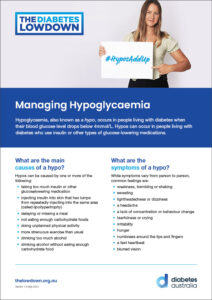What is a hypo?
A hypo – full name hypoglycaemia – occurs in people with diabetes when their blood glucose level drops below 4mmol/L.
Hypos can occur in people with diabetes who take insulin or other types of glucose-lowering medications.
What causes a hypo?
Hypos can be caused by one or more of the following:
- too much insulin or other glucose-lowering medication
- injecting insulin into skin that has lumps from repeatedly injecting into the same area (called lipohypertrophy)
- delaying or missing a meal
- not eating enough carbohydrate foods
- unplanned physical activity or more strenuous exercise than usual
- drinking too much alcohol or drinking alcohol without eating enough carbohydrate food.
What are the symptoms?
While symptoms vary from person to person, common feelings include:
- weakness, trembling or shaking
- sweating
- light headedness or dizziness
- headache
- lack of concentration or behaviour change
- tearfulness or crying
- irritability
- hunger
- numbness around the lips and fingers
- a fast heartbeat
- blurred vision.
If you feel any of these symptoms, check your blood glucose level. If you can’t do this, treat these symptoms as if you are having a hypo.
How do you treat a hypo?
It’s important to treat a hypo quickly to stop your blood glucose level from falling even lower. Untreated hypos can be dangerous and can put you at risk of falling unconscious. The first thing to do is to ensure you are safe. For example, if you are driving a vehicle, pull over to the side of the road.
Step 1:
Most important! Have some easily absorbed carbohydrate (that you find easy to swallow) this could include:
- glucose tablets equal to 15g of carbohydrate OR
- 6–7 regular jellybeans or 4 large glucose jellybeans OR
- 1 tube of oral glucose gel (equal to 15g of carbohydrate) OR
- 1/2 a can (150mL) of regular (not diet) soft drink OR
- 3 teaspoons of sugar or honey OR
- 1/2 a glass (125mL) of fruit juice.
After 15 minutes, recheck your blood glucose level to make sure it has risen above 4mmol/L. If it hasn’t, repeat step 1.
Step 2:
Once your blood glucose level is above 4mmol/L, you will need to eat some extra carbohydrate. If your next meal is more than 20 minutes away, eat some carbohydrate food such as:
- 1 slice of bread OR
- 1 glass (250mL) of milk or soy milk OR
- 1 piece of fruit OR
- 4 dried apricots OR
- 1 tablespoon sultanas OR
- 1 small tub (100g) fruit yoghurt.
For individualised advice on hypo treatment, talk to your doctor or diabetes health professional. Insulin pumps and continuous glucose monitoring (CGM): if you are using an insulin pump or CGM, talk to your diabetes healthcare team about how to treat and manage hypos.
What happens if a hypo is not treated?
If left untreated, blood glucose levels will continue to drop, and this may lead to severe hypoglycaemia (unconsciousness or seizures). A severe hypo is one that you can’t treat yourself and where you need help from someone else.
You may like to tell your family and friends that you have diabetes and what to do in the case of a severe hypo.
Your doctor or diabetes educator may recommend you always carry glucagon with you in case of a severe hypo. You or your diabetes healthcare team can show your family or friends how to use it. Glucagon is a hormone, given by injection, that raises the blood glucose level.
If you have experienced a severe hypo, notify your doctor as soon as possible to discuss the cause of the hypo and to review your diabetes management plan. You can also discuss when you should return to your normal activities, such as driving.
Managing Hypoglycaemia (PDF)
Download this helpful fact sheet to learn more about hypoglycaemia and how to manage it.

